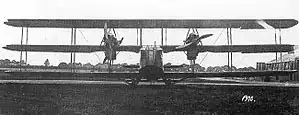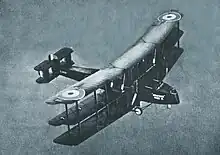| Bristol Types 24 and 25 Braemar | |
|---|---|
 | |
| Braemar second prototype, 1919 | |
| Role | Heavy bomber |
| National origin | United Kingdom |
| Manufacturer | Bristol Aeroplane Company |
| Designer | Frank Barnwell |
| First flight | 13 August 1918 |
| Number built | 2 |
| Developed into | Bristol Pullman |
The Bristol Braemar was a British heavy bomber aircraft developed at the end of the First World War for the Royal Air Force. Only two prototypes were constructed.
Development
The prototype Braemar was developed in response to the establishment of the Independent Air Force in October 1917, as a bomber capable of the long-range bombing of Berlin if necessary. A large triplane, it had internal stowage for up to six 250 lb (110 kg) bombs.
The initial design featured an unusual engine installation with a central engine room housing all four engines. These were to be geared in pairs and power taken from the engines to the four propellers by power shafts. This design was abandoned early in development, and both the completed Braemars had a conventional engine installation, with the engines in inline tandem pairs, driving pusher and tractor propellers. However, the engine-room design was resurrected later in the Braemar's development life, for the proposed steam-powered Tramp.
A contract from the Air Board for three prototypes was awarded to Bristol & Colonial on 26 February 1918. The first prototype Braemar flew on 13 August 1918, with four 230 hp (170 kW) Siddeley Puma engines. The prototype showed generally good performance with a top speed of 106 mph (171 km/h), but there were complaints from the test pilots about the view from the cockpit and the controls,[1] and so the next aircraft produced was an improved version designated Braemar Mk.II. The Mk.II received considerably more power from its four 400 hp (300 kW) Liberty L-12 engines, which gave it an improved speed of 125 mph (201 km/h).
The Braemar never entered service with the RAF, and the two prototypes were the only Braemars built. The third prototype was completed as a Pullman 14-passenger civil transport.
Variants

- Type 24 Braemar I
- Prototype with four 230 hp (172 kW) Siddeley Puma engines, one built first flown 13 March 1918.
- Type 25 Braemer II
- Prototype with four 400 hp (298 kW) Liberty L-12 engines, one built first flown 18 February 1919.
- Type 26 Pullman
- 14-passenger civil transport variant with Liberty L-12 engines, one built first flown in May 1920.
Specifications (Braemar Mk.II)
Data from Bristol Aircraft since 1910[2]
General characteristics
- Crew: 6 - 2 pilots, wireless operator, engineer and two gunners
- Length: 51 ft 6 in (15.70 m)
- Wingspan: 81 ft 8 in (24.89 m)
- Height: 20 ft (6.1 m)
- Wing area: 1,905 sq ft (177.0 m2)
- Empty weight: 10,650 lb (4,831 kg)
- Gross weight: 16,500 lb (7,484 kg)
- Powerplant: 4 × Liberty L-12 V-12 water-cooled piston engines, 400 hp (300 kW) each in two tandem nacelles mounted on the mid wing
- Propellers: 2-bladed fixed-pitch pusher and tractor propellers
Performance
- Maximum speed: 106 mph (171 km/h, 92 kn)
- Range: 1,000 mi (1,600 km, 870 nmi) +
- Service ceiling: 17,000 ft (5,200 m)
- Wing loading: 9.45 lb/sq ft (46.1 kg/m2)
- Power/mass: 0.08 hp/lb (0.13 kW/kg)
Armament
- Guns: 2 × 0.303 in (7.7 mm) machine guns
- Bombs: 1,500 lb (680 kg)
See also
Related development
Aircraft of comparable role, configuration, and era
Related lists
References
Citations
- ↑ The pilots were no longer able to feel sideslip through the wind on their faces (Flight 12 February 1960 p208)
- ↑ Barnes, C.H. (1964). Bristol Aircraft since 1910 (1st ed.). London: Putnam & Company Ltd. pp. 138–142.
Bibliography
- Barnes C.H. (1964). Bristol Aircraft Since 1910. Putnam & Company Ltd. ISBN 0-370-00015-3.
- "Two Tri-Quads", Flight: 209, 5 March 1942